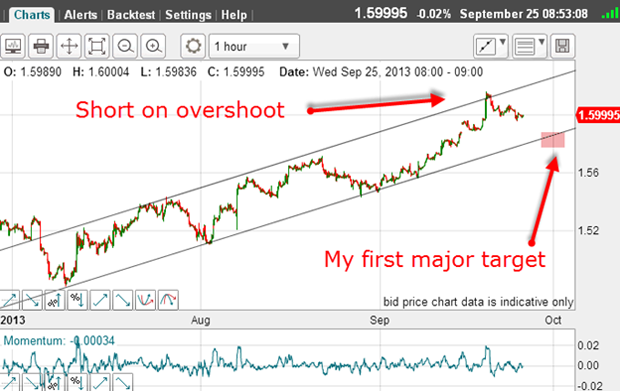How to manage your winning trades
Knowing when to take profits on a winning trade can be a major dilemma. John C Burford explains why it pays to have a reliable system in place.
Last Friday, I covered my GBP/USD trade. The market had hit my target at 1.61 with a slight overshoot and was backing off. This was the position then:

I pointed out that the overshoot of the upper tramline is a typical reaction to a development that the market was not expecting. That was the surprise decision last Wednesday by the Fed not to start reducing their bond purchases in September, as the market was expecting.
This has set up the real possibility for a trend reversal, since tramline overshoots, when they come at the end of an extended run, are often a sign of exhaustion of the trend.
MoneyWeek
Subscribe to MoneyWeek today and get your first six magazine issues absolutely FREE

Sign up to Money Morning
Don't miss the latest investment and personal finances news, market analysis, plus money-saving tips with our free twice-daily newsletter
Don't miss the latest investment and personal finances news, market analysis, plus money-saving tips with our free twice-daily newsletter
Why is this? As the market rallies, it draws in shorts who try to pick the top, convinced that the market is overbought. And as the market climbs higher, many of these shorts are stopped out, adding to the buying pressure.
On a spike move, such as an overshoot, many of the last remaining spec shorts throw in the towel and cover their positions, unable to suffer any more pain.
When they have done their buying, there is a dearth of new buyers to support prices. That's when the market sinks, as normal selling some profit-taking by the longs is enough to drive prices lower. And that is what occurs when the market spikes in an overshoot and then retreats back inside the trading channel.
When to take profits?

Now, the trade is in profit. The big question is how to handle it.
If I have found the top at 1.6150, ideally I would like to see a small-scale five-wave Elliott pattern down. That is usually a sign that the trend has indeed turned.
Here is a close-up:

I have a very respectable Elliott wave count here and with my wave 3 containing five sub-waves. I have a positive-momentum divergence at yesterday's low to confirm my count.
Also, the decline has taken it to the Fibonacci 23% retrace of the big move up from the late August low.
Putting this together, a bounce of some sort is on the cards.
The importance of trade management
Whatever decision you make is dependent on your trading style. A shoot-from-the-hip style trader would likely grab the profit and run, and get busy seeking out another opportunity.
But a more conservative trader would likely keep stop at break-even and let the market decide its moves, content in the knowledge that the trade will not lose money.
Of course, the market may decide to ignore these bullish signals and resume its downtrend towards my major target at the lower tramline in the 1.58-1.59 area.
Management of your trades is one of the great conundrums of trading where to take profits and it pays to have a system. Without a method, you will be left floundering around and probably be very frustrated at missing some great moves, or seeing a good profit vanish by poor stop placement.
Get the latest financial news, insights and expert analysis from our award-winning MoneyWeek team, to help you understand what really matters when it comes to your finances.
John is is a British-born lapsed PhD physicist, who previously worked for Nasa on the Mars exploration team. He is a former commodity trading advisor with the US Commodities Futures Trading Commission, and worked in a boutique futures house in California in the 1980s.
He was a partner in one of the first futures newsletter advisory services, based in Washington DC, specialising in pork bellies and currencies. John is primarily a chart-reading trader, having cut his trading teeth in the days before PCs.
As well as his work in the financial world, he has launched, run and sold several 'real' businesses producing 'real' products.
-
 Why pension transfers are so tricky
Why pension transfers are so trickyInvestors could lose out when they do a pension transfer, as the process is fraught with risk and requires advice, says David Prosser
-
 The political economy of Clarkson’s Farm
The political economy of Clarkson’s FarmOpinion Clarkson’s Farm is an amusing TV show that proves to be an insightful portrayal of political and economic life, says Stuart Watkins